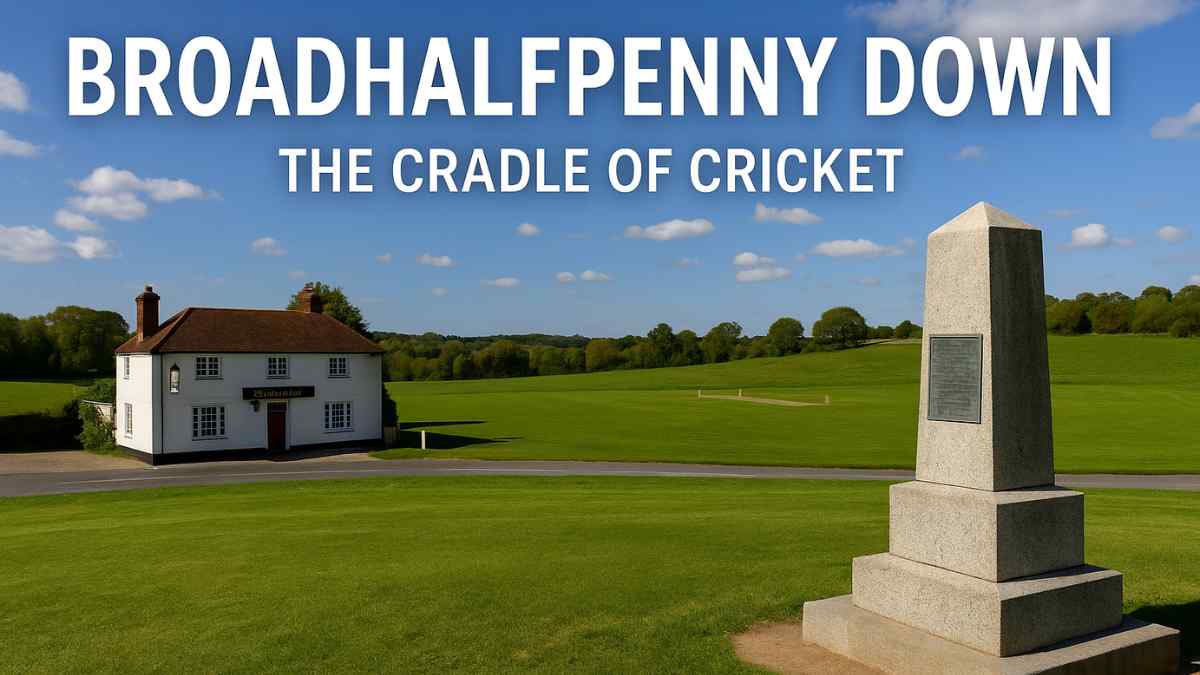Broadhalfpenny Down: The Cradle of Cricket and the Spirit of English Heritage

Broadhalfpenny Down is more than just a name etched in the history books of cricket—it is the very foundation upon which the modern game was built. Nestled in the gentle hills of Hampshire, England, this historic ground has been celebrated for centuries as the “Cradle of Cricket.” Its green slopes and rural surroundings tell the story of a sport that began humbly as a local pastime and grew to become one of the most beloved games in the world.
The beauty of Broadhalfpenny Down lies not only in its historical value but also in its enduring spirit. Generations of cricketers, from 18th-century gentlemen to today’s passionate players, have stepped on its turf. To truly understand cricket’s origins and evolution, one must explore this iconic field and the community that nurtured it.
The Origins of Broadhalfpenny Down
The roots of Broadhalfpenny Down can be traced back to the mid-18th century, a time when cricket was transforming from a rustic leisure activity into a structured and competitive sport. It was here, around the 1750s, that the famous Hambledon Club began playing regular matches. This club became the heartbeat of early cricket, drawing players, patrons, and spectators from across southern England.
At a time when there were no official cricket boards or professional leagues, Hambledon Club’s matches on Broadhalfpenny Down were the ultimate gatherings for cricket enthusiasts. The ground, positioned on an open ridge with sweeping countryside views, provided a perfect setting for long summer contests. The atmosphere was festive, yet competitive, with wagers often placed on the outcome—a reflection of the Georgian era’s love for sport and gambling.
The First Recorded Matches
One of the earliest and most significant events in Broadhalfpenny Down’s history occurred in June 1772. This was when the ground hosted what many historians regard as the first officially recorded “first-class” cricket match. The teams were Hampshire and an All-England XI, and although the rules were still evolving, the match was played with a seriousness that marked cricket’s shift into a more organised sport.
The players of Hambledon Club were not only athletes but innovators. They experimented with batting techniques, refined the art of bowling, and established fielding positions that remain familiar today. Their matches on Broadhalfpenny Down became the blueprint for the modern game.
The Role of the Hambledon Club
Hambledon Club’s rise coincided with Broadhalfpenny Down’s golden age. Founded around 1750, the club was composed of gentlemen, landowners, and skilled cricketers who shared a passion for the sport. The club’s members helped shape the laws of cricket, turning what was once a rural pastime into a codified, respected discipline.
Their influence was so profound that many of the laws formulated by the club became the foundation for what later evolved into the official Laws of Cricket. Innovations such as the width of the bat, the length of the pitch, and the introduction of the middle stump can all trace their roots back to this era.
Broadhalfpenny Down became the stage upon which these new rules were tested and perfected. Every match held here contributed to refining the spirit and structure of cricket. It was a living laboratory of sport, where tradition met experimentation, and where camaraderie mixed with competition.
The Bat & Ball Inn – A Pub Steeped in History
No mention of Broadhalfpenny Down would be complete without the Bat & Ball Inn, the historic pub that stands just opposite the ground. Originally known as “The Hut,” this inn was more than a place to drink—it was the social headquarters of the Hambledon cricketers.
Richard Nyren, one of the most respected figures in early cricket and captain of the Hambledon Club, served as the landlord of the Bat & Ball Inn for a decade. Players would gather here before and after matches, discussing tactics, celebrating victories, and debating the finer points of the game. The pub still exists today, a living relic of cricket’s earliest culture, preserving the memory of those who laid the sport’s foundations.
A Monument to the Past
In 1908, a granite monument was erected on Broadhalfpenny Down to honour its historic role in cricket’s birth. The monument stands as a tribute to the Hambledon Club and to the countless matches that took place on these grounds more than two centuries ago. Engraved upon it are the words that remind visitors of the ground’s legacy—the birthplace of the organised game that has since captured the hearts of millions worldwide.
For lovers of sport, this site is sacred ground. Visiting Broadhalfpenny Down today is like stepping back in time, where the echoes of wooden bats and cheering crowds still seem to linger on the wind.
The Decline and Revival
By the early 1780s, cricket’s popularity had expanded beyond Hampshire. The Hambledon Club, once the central authority of cricket, began to lose its influence as London clubs, particularly the Marylebone Cricket Club (MCC), rose to prominence. The MCC would later take over the formal codification of cricket’s laws, building upon the groundwork laid at Hambledon.
As the Hambledon Club shifted its matches to a nearby ground called Windmill Down, Broadhalfpenny’s activity declined. For a time, the field fell quiet, its grass reclaiming the footsteps of legendary players. Yet its spirit never truly faded.
In the 20th century, local enthusiasts reignited interest in the site. The Broadhalfpenny Brigands Cricket Club, founded in 1959, began hosting matches on the ground again, bringing back life and laughter to this historic pitch. Today, it is home to regular fixtures for men, women, and junior cricketers, ensuring that Broadhalfpenny Down remains not just a monument to the past, but a living, breathing part of English cricket culture.
The Cultural Impact of Broadhalfpenny Down
Broadhalfpenny Down’s influence reaches far beyond sport—it represents English rural life, tradition, and the spirit of community. Cricket in its early form was not just a game; it was a social event, a gathering that brought together people from all walks of life. Farmers, landowners, and townsfolk would stand side by side, united by their shared love for the game.
This cultural unity is still visible today. Matches at Broadhalfpenny Down maintain a festive atmosphere, blending competitive play with the charm of old English countryside leisure. The rolling hills, the scent of freshly cut grass, and the timeless view of the Bat & Ball Inn all combine to create a sense of continuity that few other sporting venues can offer.
The Evolution of the Game
The cricket we watch today—with its global tournaments, million-pound contracts, and vast stadiums—owes much to the modest beginnings at Broadhalfpenny Down. The spirit of fairness, discipline, and gentlemanly conduct that defines cricket was born here.
In the 18th century, players wore simple white linen, used hand-crafted bats, and played on uneven pitches. There were no helmets, no television coverage, and no boundary ropes. Yet the same passion, skill, and strategy that captivate fans today were all present.
Broadhalfpenny Down serves as a reminder that even global phenomena have humble beginnings. It tells the story of how patience, dedication, and love for the game can shape history.
Visiting Broadhalfpenny Down Today
Today, Broadhalfpenny Down remains open to visitors and players alike. It continues to host matches under the stewardship of the Broadhalfpenny Brigands, keeping the heritage alive. Modern visitors can enjoy not only the cricket but also the scenic beauty of Hampshire’s countryside. The Bat & Ball Inn still welcomes guests, serving local ales and traditional English fare to those who come to pay homage to cricket’s birthplace.
Walking across the field, one can easily imagine the sounds of 18th-century matches—the crack of the bat, the murmur of the crowd, and the pride of players who had no idea they were shaping history. It is this connection to the past that makes Broadhalfpenny Down a uniquely powerful place to visit.
A Symbol of Heritage and Continuity
Broadhalfpenny Down stands as a timeless symbol of heritage and continuity. In a world of constant change, it reminds us of the importance of roots and tradition. Cricket has evolved, technology has transformed the sport, but the values of respect, sportsmanship, and community—first embodied here—remain unchanged.
The ground has witnessed centuries of history, survived wars, social change, and industrialisation, yet its essence remains the same. It continues to represent the charm of rural England and the enduring appeal of a game that unites people across generations.
Why Broadhalfpenny Down Still Matters
For historians, cricketers, and tourists alike, Broadhalfpenny Down is a pilgrimage site. It encapsulates not just the story of a sport, but of English culture itself. The ground connects the past with the present, reminding us that greatness often begins in the most modest of places.
Its preservation and continued use highlight the value of maintaining our historical landmarks. They are living testaments to human creativity and shared identity. In every match played here today, there lies a thread that ties modern cricketers to those 18th-century pioneers who once played for love, pride, and the sheer joy of the game.
Conclusion
Broadhalfpenny Down is not merely a cricket ground—it is the birthplace of a tradition that defines England’s sporting soul. From its rolling green slopes and the echoes of the Hambledon Club’s glory days to the timeless pub that still stands as a guardian of cricket’s heritage, this place embodies history, nostalgia, and inspiration.
To visit Broadhalfpenny Down is to experience the origins of cricket in their purest form. It reminds us that the heart of sport lies not in fame or fortune, but in the community, passion, and values that bring people together. The legacy born here continues to shape the world of cricket, making Broadhalfpenny Down truly deserving of its title—The Cradle of Cricket.



